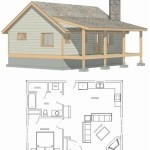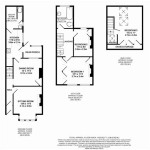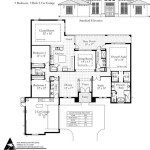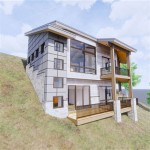Simple 3 Bedroom Floor Plan With Dimensions In Meters
A simple 3-bedroom floor plan is a popular choice for many families due to its balance between affordability, space, and functionality. Such a floor plan generally incorporates three bedrooms, a living area, a kitchen and dining space, and at least one bathroom. Optimizing the layout of these spaces within a specific footprint, typically measured in meters, is crucial for creating a comfortable and efficient living environment. This article will explore the considerations and examples of simple 3-bedroom floor plans, emphasizing the importance of dimensions in creating a practical and well-designed home.
When designing a 3-bedroom house, it is fundamental to determine the overall size of the house. A smaller 3-bedroom home may be between 70 to 90 square meters, while a larger one could range from 100 to 120 square meters or more. The dimensions of each room will depend on the total area available, as well as the desired proportions and functionality of each space. The orientation of the house on the lot and the placement of windows and doors are also important aspects to consider during the planning phase. These elements impact natural light, ventilation, and the overall flow of the house.
Key Point 1: Essential Room Dimensions for a 3-Bedroom House
Understanding the minimum and optimal dimensions for each room is crucial. The master bedroom in a 3-bedroom house typically requires a larger space than the other two bedrooms. A standard master bedroom might be around 4 meters by 4 meters (16 square meters) to comfortably accommodate a king-size bed, bedside tables, and a wardrobe. Smaller secondary bedrooms can be around 3 meters by 3 meters (9 square meters) or 3 meters by 3.5 meters (10.5 square meters), which is sufficient for a single bed, a desk, and a small closet. The dimensions of each secondary bedroom should be carefully considered in relation to the intended use and anticipated occupancy.
The living area should be large enough to comfortably accommodate seating arrangements and possibly a television unit. A living room around 4 meters by 5 meters (20 square meters) to 5 meters by 6 meters (30 square meters) is generally adequate. For the kitchen, a galley-style kitchen of around 2 meters by 4 meters (8 square meters) can be efficient, while a larger kitchen with an island might require 3 meters by 5 meters (15 square meters) or more. The dining area, if separate, could be around 3 meters by 3 meters (9 square meters) to accommodate a dining table and chairs comfortably. The bathroom size will depend on whether it includes a bathtub, shower, toilet, and sink. A small bathroom can be around 1.5 meters by 2 meters (3 square meters), while a larger bathroom could be 2 meters by 3 meters (6 square meters) or more. Hallways and entryways should be at least 1 meter wide to allow for easy movement.
When considering these dimensions, it's important to factor in wall thickness and the space occupied by doors. Interior walls generally range from 100mm to 150mm in thickness. Doorways typically require a clearance of at least 800mm. These details have an impact on the usable space within each room. Careful consideration of these measurements will ensure that the actual living space meets the desired standards.
Key Point 2: Layout Considerations and Space Optimization
The layout is the backbone of any floor plan. A well-designed layout optimizes the flow of movement within the house and maximizes usable space. Open-concept layouts, where the living room, dining area, and kitchen are combined, can create a sense of spaciousness, even in smaller homes. This type of layout typically requires careful planning of furniture placement to define each zone within the open space.
Another important aspect is the arrangement of bedrooms. Separating the master bedroom from the secondary bedrooms can enhance privacy. Consider positioning the master bedroom at one end of the house and the secondary bedrooms at the other end, possibly utilizing a hallway as a buffer. The placement of bathrooms should be central for ease of access from all parts of the house. Having a separate toilet and shower/bath facilities can also improve the functionality of the bathroom.
Closet space is often overlooked but essential for storage. Each bedroom should have a closet, ideally with dimensions of at least 600mm deep and 1.5 meters wide. Built-in wardrobes can save space and provide ample storage. Linen closets near the bathrooms and a storage closet near the entryway can also be beneficial. Vertical space should also be considered, incorporating shelves and cabinets to maximize storage capacity. Optimizing the use of corners can also create additional storage areas within the house.
The orientation of the house relative to the sun's path can impact the energy efficiency and comfort of the home. In climates with hot summers, orienting the house so that the long axis faces north-south can reduce direct sunlight exposure on the east and west sides, minimizing heat gain. In cooler climates, orienting the house to maximize southern exposure can help to heat the house naturally during the day. The placement of windows and doors should be carefully considered to maximize natural light and ventilation while minimizing heat loss or gain. Strategic landscaping can also provide shade and windbreaks, further enhancing the energy efficiency of the house.
Key Point 3: Examples of Simple 3-Bedroom Floor Plans with Dimensions
To illustrate the principles discussed, consider a few examples of 3-bedroom floor plans with dimensions in meters. Note that these are simplified examples, and actual dimensions may vary based on specific requirements and local building codes.
Example 1: Compact 3-Bedroom Plan (75 square meters)
This plan features a rectangular layout with dimensions of roughly 7.5 meters by 10 meters. The master bedroom is located at one end of the house, measuring 3.5 meters by 4 meters. Two smaller bedrooms, each measuring 3 meters by 3 meters, are situated at the opposite end of the house. A shared bathroom, measuring 1.8 meters by 2 meters, is centrally located between the secondary bedrooms. The living area, measuring 4 meters by 5 meters, flows into a small kitchen and dining area that is 3.5 meters by 3 meters. A small hallway provides access to all rooms. This plan prioritizes functionality and compact living.
Example 2: Open-Concept 3-Bedroom Plan (90 square meters)
This plan is designed around an open-concept living area. The house has dimensions of approximately 9 meters by 10 meters. The master bedroom, measuring 4 meters by 4.5 meters, features an ensuite bathroom of 1.8 meters by 2 meters. The other two bedrooms, each measuring 3 meters by 3.5 meters, share a central bathroom measuring 2 meters by 2.5 meters. The open-concept living, dining, and kitchen area spans roughly 5 meters by 6 meters, offering ample space for socializing and entertaining. A small laundry room is located near the kitchen for convenience. This plan emphasizes spaciousness and connectivity between living areas.
Example 3: Split-Bedroom 3-Bedroom Plan (110 square meters)
This plan separates the master bedroom from the secondary bedrooms for increased privacy. The house has dimensions of approximately 10 meters by 11 meters. The master bedroom, located at one end of the house, measures 4.5 meters by 5 meters and includes a walk-in closet and an ensuite bathroom measuring 2.2 meters by 3 meters. The two secondary bedrooms, each measuring 3.5 meters by 4 meters, are located at the opposite end of the house and share a bathroom measuring 2 meters by 3 meters. The living area, measuring 5 meters by 6 meters, is centrally located and opens onto a dining area measuring 4 meters by 4 meters. The kitchen, measuring 3 meters by 4 meters, is adjacent to the dining area and accessible from the living area. A separate entryway and a small home office or study area complete the plan. This plan offers a balance of privacy, spaciousness, and functionality.
These examples demonstrate how varying the dimensions of each room and the layout can significantly impact the overall feel and functionality of a 3-bedroom house. When selecting a floor plan, it is important to consider individual needs, lifestyle, and budget. Consulting with an architect or designer can help to tailor a floor plan to meet specific requirements and ensure compliance with local building codes. Carefully considering all aspects of the design, from room dimensions to layout and orientation, is essential for creating a comfortable, efficient, and enjoyable living space.
Beyond the physical dimensions, consider the psychological impact of space. Rooms that feel cramped can lead to stress, while rooms with ample space promote relaxation and well-being. Natural light is crucial for creating a positive atmosphere. Large windows and skylights can flood the interior with light, making the space feel brighter and more inviting. The use of color and materials can also have a significant impact on the perceived size and feel of a room. Light colors tend to make spaces feel larger, while darker colors can create a sense of intimacy. Mirrors can also be used to create the illusion of more space.

Three Bedroom House Concept Pinoy Eplans Plan Small Design

5 Home Plans 11x13m 11x14m 12x10m 13x12m 13x13m House Plan Map Bungalow Floor Design

A Two Dimensional Drawing Showing The Floor Plan Of Three Bedroom Scientific Diagram

3 Bedroom Small House Plans For Narrow Lots Nethouseplansnethouseplans

Classic Layout 3 Bedroom Apartment 105 Sq M Floorplans24 Delivers A Solution That Works For You Talk To Us Flat Plan Deck Barn

House Plans 9x13 5 With 3 Bedrooms Samhouseplans

Small Bungalow House Design And Floor Plan With 3 Bedrooms One Y Plans Home

Three Bedroom Colonial House Cool Concepts

Three Bedroom Bungalow House Plan 9733

Simple Three Bedroom House Plans To Construct On A Low Budget Co Ke








